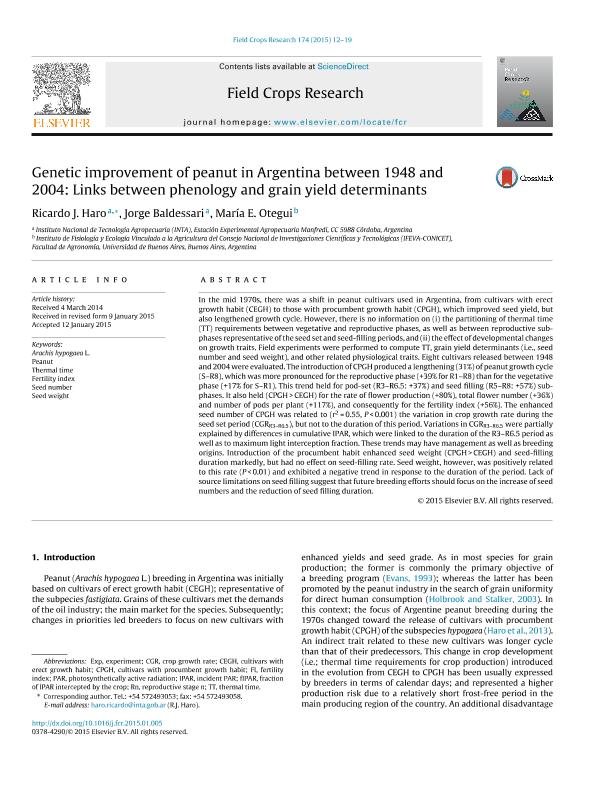Artículo
Genetic improvement of peanut in Argentina between 1948 and 2004: Links between phenology and grain yield determinants
Fecha de publicación:
03/2015
Editorial:
Elsevier
Revista:
Field Crops Research
ISSN:
0378-4290
Idioma:
Inglés
Tipo de recurso:
Artículo publicado
Clasificación temática:
Resumen
In the mid 1970s, there was a shift in peanut cultivars used in Argentina, from cultivars with erect growth habit (CEGH) to those with procumbent growth habit (CPGH), which improved seed yield, but also lengthened growth cycle. However, there is no information on (i) the partitioning of thermal time (TT) requirements between vegetative and reproductive phases, as well as between reproductive sub-phases representative of the seed set and seed-filling periods, and (ii) the effect of developmental changes on growth traits. Field experiments were performed to compute TT, grain yield determinants (i.e., seed number and seed weight), and other related physiological traits. Eight cultivars released between 1948 and 2004 were evaluated. The introduction of CPGH produced a lengthening (31%) of peanut growth cycle (S–R8), which was more pronounced for the reproductive phase (+39% for R1–R8) than for the vegetative phase (+17% for S–R1). This trend held for pod-set (R3–R6.5: +37%) and seed filling (R5–R8: +57%) sub-phases. It also held (CPGH > CEGH) for the rate of flower production (+80%), total flower number (+36%) and number of pods per plant (+117%), and consequently for the fertility index (+56%). The enhanced seed number of CPGH was related to (r2 = 0.55, P < 0.001) the variation in crop growth rate during the seed set period (CGRR3–R6.5), but not to the duration of this period. Variations in CGRR3–R6.5 were partially explained by differences in cumulative IPAR, which were linked to the duration of the R3–R6.5 period as well as to maximum light interception fraction. These trends may have management as well as breeding origins. Introduction of the procumbent habit enhanced seed weight (CPGH > CEGH) and seed-filling duration markedly, but had no effect on seed-filling rate. Seed weight, however, was positively related to this rate (P < 0.01) and exhibited a negative trend in response to the duration of the period. Lack of source limitations on seed filling suggest that future breeding efforts should focus on the increase of seed numbers and the reduction of seed filling duration.
Palabras clave:
Arachis Hypogaea L.
,
Peanut
,
Thermal Time
,
Fertility Index
,
Seed Number
,
Seed Weight
Archivos asociados
Licencia
Identificadores
Colecciones
Articulos(IFEVA)
Articulos de INST.D/INV.FISIOLOGICAS Y ECO.VINCULADAS A L/AGRIC
Articulos de INST.D/INV.FISIOLOGICAS Y ECO.VINCULADAS A L/AGRIC
Citación
Haro, Ricardo J.; Baldessari, Jorge; Otegui, Maria Elena; Genetic improvement of peanut in Argentina between 1948 and 2004: Links between phenology and grain yield determinants; Elsevier; Field Crops Research; 174; 3-2015; 12-19
Compartir
Altmétricas




